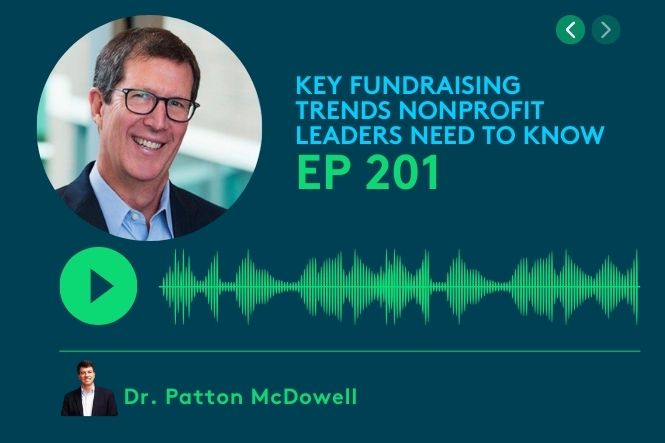Fundraising Trends: A Discussion Between Matt Nash and Patton McDowell

August 24, 2023 | 6 min read
When considering the year ahead, it’s essential to consider new or developing trends since you set your last plan. Doing so will ultimately spark new ideas or methods to maximize your time and resources. The Blackbaud Giving Fund’s Executive Director Matt Nash sat down with Patton McDowell, host of Your Path to Nonprofit Leadership podcast, to discuss trends nonprofits should consider in 2023, including donor’s intentionality, strategy, digital giving, crypto, and more.
Here are six highlights from their conversation. Curious to hear the whole interview? Listen here [link to audio hosted on the website].
- Intentional giving trends. Research on donor-advised fund (DAF) donors shows the majority of their charitable giving comes from money they intentionally set aside for charitable purposes, while the minority of their charitable giving is reactionary. Intentional giving is a cause that is important to the donor and they are inspired to give to specific charities that support this cause. Reactionaly giving is responding to a friend’s run for charity or participating in an auction that was attended for social reasons.
When you look at DAF donors, nothing in their behavior says they are stashingmoney away. It doesn’t make much financial sense to give $1,000 to a DAF, let it sit there, and get, at best, a 30% reduction on taxes from a charitable donation. DAF trends show that donors want the ability to move their funds quickly to causes in need or experiencing crises. Also, donors often use DAFs to sustain their giving into retirement so that they can give as much in their later years in life as they can while they are working. (Timestamp: 2:30) - Strategy matters both for the donor and the nonprofit. When I was helping donors start their DAFs, I learned they were good at making money in their careers but hadn’t spent much time thinking about giving. It’s easy to give away money, but it’s difficult to do it intelligently. For donors, the key is to think through causes they are passionate about, the change they want to see or make in the world, etc. Donors using DAFs are intentional about giving, which means they’re thinking about being effective and having a strategy to become better philanthropists.
Nonprofits must also focus on their strategy to determine how they should run their organizations, serve needs, etc. But it’s almost as important to have a strategy so you know when to pivot. Sometimes, the best reason to have a plan is to know when to divert from it. If the needs you’re trying to meet change or the environment shifts, you must know when to change strategy to meet new demands. Strategy is a living word. You continually adopt, adapt, change, reinvent, and rethink as you go.
You have to inspire the donor. But you have to know what inspires them. Once you discover that, it’s easier to position how they can support the impact you’re trying to make. (Timestamp: 19:20) - Giving in a digital world is here to stay, so identify key giving channels. In 2021, individuals donated $58 billion using digital platforms. DAFs, which are also digital, added another $35 billion, totaling $93 billion in gifting and 19% of individual giving. Digital giving is growing quickly because it’s a successful strategy. Many platforms offer online giving beyond a donate button on a website.
There are many options, and it can be overwhelming for a nonprofit; the key is understanding which fundraising technology is most impactful to your nonprofit. Pick your most successful avenues when you see where the funds are coming from. From there, identify trends to use as a starting point. Look into your databases to find out who’s behind the donation. DAFs, for instance, are one of the many groups that can overwhelm a nonprofit. 90% of DAF donors give their name and their address. However, the nonprofit’s systems often won’t show contact information upfront. You may have to do a little digging to find it. (Timestamp: 23:25) - Money from donor-advised funds is disbursed quickly. I heard a presentation from the community foundation president, who recounted his experience during a water crisis. Before government grants, foundations, and other communities rallied, money from DAFs quickly flowed into the city. The community made a distribution plan to bring residents food, water, and other vital resources, and the DAF money allowed them to act faster because it came in quicker. When crises happen, causing a nonprofit’s priorities to shift, the donors supporting that nonprofit can quickly move money to meet those needs. (Timestamp: 30:30)
- 75% of donors donate where they volunteer. When donors get to know an organization, they see the fantastic work people are doing and how dedicated they are, which makes them want to give. The key is connections. The more you connect with people, the more people will want to support you. One way to establish those connections is through workplace-giving platforms like NPOconnect from Blackbaud. Workplace giving is growing because people want to work for companies making an impact, and more companies are creating initiatives to support local communities.
The top three organizations that provide workplace-giving vehicles to corporate America collectively reach 20 million employees. That’s a huge marketplace of potential donors that nonprofits should tap into. Corporations want to connect their employees to nonprofits to make an impact in their communities. Connections and employees are a powerful combination. (Timestamp: 33:30) - Some people think crypto is coming, while others think it’s going. Crypto is a volatile asset which means sometimes it’s going to be high, and sometimes it’s going to be low. 20% of Americans and 33% of millennials own crypto, so it should be a part of a nonprofit’s strategy. The advantage of crypto is that you can have periods when the cost basis is low, and the value is high, which is a perfect asset for donors to give to nonprofits.
While crypto can seem complicated and risky, there are organizations to help nonprofits process and sell the crypto, which takes a lot of the risk out of the equation. Nonprofits can take advantage of crypto, and there will be high times and low times, but it can represent large windfalls for donors who want to take advantage of it and donate to nonprofits. If you consider crypto as a non-cash asset that can turn into charitable funds, it can be an extremely beneficial asset. (Timestamp: 38:20)
To learn more about The Blackbaud Giving Fund, visit blackbaudgivingfund.org, or follow the organization on LinkedIn, Facebook, and Instagram for updates, news, and more.
For more information about NPOconnect or to sign up, visit https://nonprofit.yourcause.com/login/create-account.


